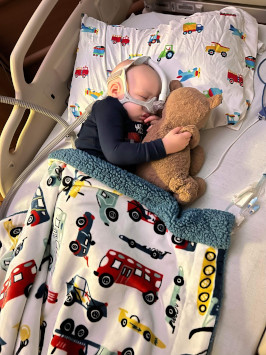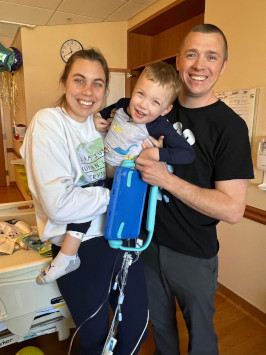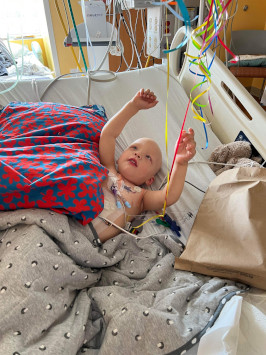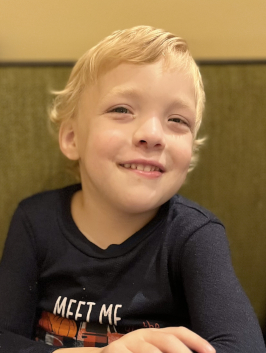Meet Tanner Ziarek





Meet Tanner, a Bluey loving three-year-old with a mischievous grin and a belly laugh that makes his mama melt. While trucks, cars and anything with wheels kept this little guy busy in the hospital; his mom, Alexandra, was delighted to relay that Tanner’s summer days were filled with bike rides and swimming with his big brothers. Now that he is finally in the maintenance phase of treatment, Tanner is attending school and experiencing the world of little joys that most people take for granted.
Tanner’s family was introduced to the grueling life of pediatric cancer in the spring of 2022. Tanner had just turned two when Alexandra noticed him having difficulty breathing. He was taken to an ENT doctor where a nose swab revealed several infections but no major concerns. But, six weeks later, Tanner looked like he had just come out on the wrong side of a fist fight- alarming bruising and swelling covered his face. A CT scan at Children’s Wisconsin revealed a large tumor on his sinus. Little Tanner was soon diagnosed with neuroblastoma, a type of cancer that forms in immature nerve tissue in the adrenal glands.
Because the adrenal glands are located deep in the body on top of each kidney, neuroblastoma often goes dangerously undetected, only discovered once it has metastasized throughout the body. Tanner’s situation was no different, his cancer was everywhere. In addition to his adrenal gland, he had tumors between his brain and skull, in his leg, sinus, jawline, throat, and bone marrow.
During his diagnostic biopsy things got even scarier than they already were. While he was sedated, Tanner simply stopped breathing. His doctor had experienced this behavior with a former neuroblastoma patient and wanted to run additional tests on him. Her suspicions were correct. Tanner had the PHOX2B gene on his fourth chromosome which gives a child a 50% risk of developing neuroblastoma. And this same gene is strongly connected to Congenital Central Hypoventilation Syndrome (CCHS), a life-long condition that can make the individual “forget to breathe” at times, especially when sleeping or sedated. This diagnosis helped his team develop a plan of action that would support Tanner throughout his upcoming therapies.
Tanner’s doctors put him on a standard course of treatment beginning with five rounds of frontline chemotherapy to destroy the smaller tumors along with resection surgery to remove the larger tumor in his abdomen. He handled this early treatment as well as could be expected, but the next phases of treatment would push Tanner and his family to dig deep for strength.
Little Tanner received back-to-back stem cell transplants with a three-week break between each infusion. Like most children recovering from transplant, he experienced extremely high fevers and endured mucositis, painful mouth sores that make eating and drinking incredibly painful. Cheetos and Danimals were what this guy lived on for weeks.
Next up was twelve rounds of radiation on his little abdomen, each treatment requiring him to be sedated. His family anxiously held their breath during these treatments, hoping his breathing could be adequately supported during each period of sedation and that the radiation wouldn’t cause long term health issues for their growing boy.
After radiation, Tanner went through several inpatient rounds of immunotherapy that would increase his chance of survival by 30%. Though immunotherapy is known for having fewer negative side effects than chemo, this regimen was incredibly painful and frightening for Tanner. As Alexandra explained it, the sensation that Tanner endured during this treatment was like burning alive¬¬—since neuroblastoma originates in nerve cells, the infusion causes extreme pain throughout a child’s body. When these agonizing treatments upset Tanner, his body would forget to breathe leading him to faint. Each time this happened, Alexandra felt helpless and terrified as she watched the respiratory transport team hook her toddler up to a BiPap, forcing him to breathe. There were many days spent in the intensive care unit during this grueling treatment.
Though Tanner is done with the most demanding phase of his therapy, he still has a long way to go before officially saying good riddance to treatment. He is currently on a maintenance regimen and enrolled in Phase 2/3 of the DFMO immunotherapy clinical trial. This drug has minimal side effects and is working to block a protein to prevent relapse. He is taking fourteen pills a day with his PediaSure like the champ he is, his family armed with the knowledge that this is moving his chance of relapse from 50 to 15%. Twenty-one more months to go with those fourteen pills.
One of the more painful moments of this journey was early on, when Alexandra learned Tanner’s PHOX2B gene is hereditary. The whole family went to the new Predisposition Clinic at Children’s Wisconsin to be tested for the gene. Alexandra, Tanner’s two brothers, and grandpa all tested positive. Since this gene puts the children at a high risk for developing neuroblastoma, they are being closely monitored by the predisposition program, receiving ultrasounds, abdominal x-rays, and other tests every six months. This will allow them to receive immediate treatment if anything is ever detected, preventing the cancer from spreading. They will be phased out of the program at 8-years-old when the risk level decreases.
Pediatric cancer has not only impacted Tanner’s childhood experience and future, but also every member of his family. His siblings have been displaced more times than Alexandra can count, moving between childcare situations so their parents could properly care for Tanner. And it’s made them face more realities and ask more serious questions than any young child should ever consider. The trauma of this whole experience has become engrained in the hearts, minds, and bodies of Tanner’s parents. It will never leave them. Childhood cancer becomes a lasting element woven into the fabric of any family.
Alexandra’s dream is for Tanner to simply outlive her because, “No child should die before their parents.” No parent should question the promise of a long life for their child.
Let’s keep pushing for better. For better, less painful therapies. For more effective treatments with fewer side effects so that our children will not only survive but thrive in full, beautiful, long lives. And yes, outlive their warrior parents who fought so very hard for that survival.
Thank you for supporting research. Thank you for giving hope.

Home >> MACC Fund >> Meet Tanner Ziarek
Learn more about The MACC Fund on the MACC Fund page.
Also Meet:
Philip Gagnon (2021)
Also Meet:
Gavin Bugalski (2020)
Also Meet:
Bo Miles (2019)
Also Meet:
Ashley Rohde (2018)
Also Meet:
Giavanna Danninger (2017)
Also Meet:
Lily and Bailey Dove (2016)
Also Meet:
Brandon Sexton (2014)
Also Meet:
Maggie Schlehlein (2013)
Also Meet:
Maggie Conlon (2012)
The MACC Fund Helps Children All Year Long

